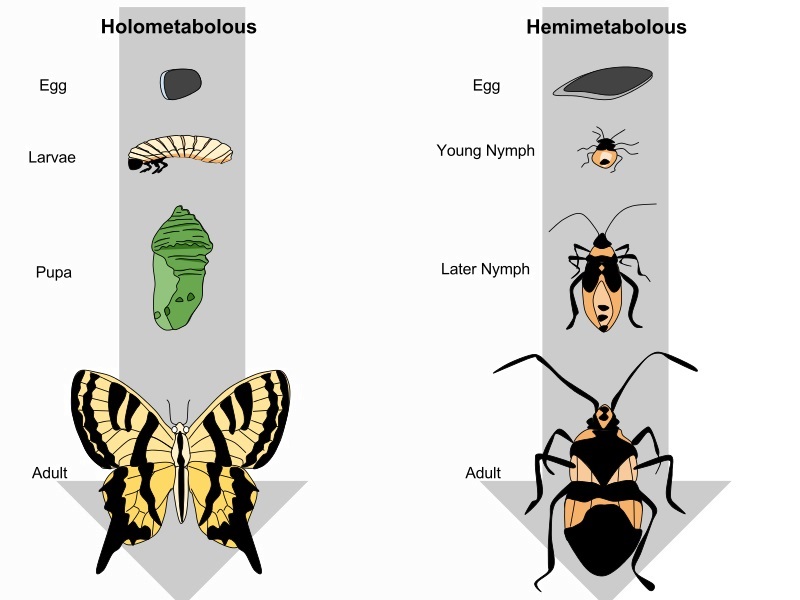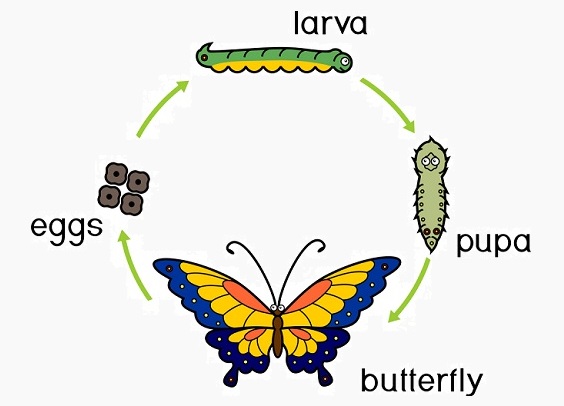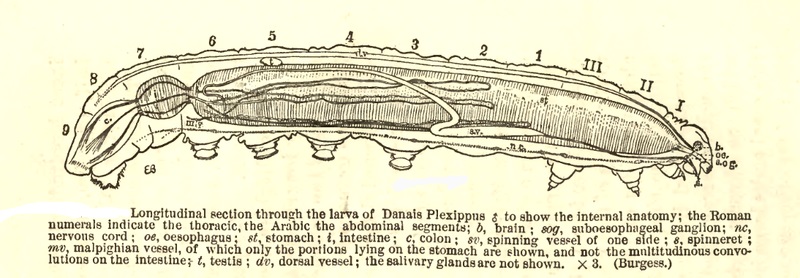Definition
Complete metamorphosis refers to change in anatomical and physiological form through a series of life stages. This occurs in the animal world, more specifically the insect world. This set of four stages – egg, larva, pupa, and adult – makes up the process of complete metamorphosis.
Complete Metamorphosis Explained
Complete metamorphosis must involve four stages. The more generic term of metamorphosis covers two different processes, one of them being complete metamorphosis, holometabolous development or holometaboly, which is almost completely specific to winged insects. In complete metamorphosis there are huge differences between larval and adult forms. This transformation requires significant energy, and is split into a sequence of changes at different stages of the insect lifecycle. The process requires so much energy, it is simply not possible to go through a complete morphological and anatomical change in one sitting. Each stage is therefore succinctly different from the stage that precedes or follows it.
Incomplete metamorphosis or hemimetabolous development, on the other hand, has only one stage that is anatomically and physiologically different – the egg form. The image below shows the different stages of complete metamorphosis in relation to incomplete metamorphosis. Note the very different forms of egg, larva, pupa, and adult (or imago) in holometaboly, and the similar nymph forms of hemimetaboly.

Complete Metamorphosis Examples
Complete metamorphosis examples cover a wide range of insect orders. The majority of holometabolous insects have wings, although there are groups which feature wingless adults. The best-known holometabolous insects are those included in the orders Lepidoptera (butterflies and moths) and Coleoptera (beetles).
Other orders that feature holometaboly are Diptera (flies), Neuroptera (including lacewings, alderflies and mayflies), Siphonaptera (fleas), and Hymenoptera (ants, bees and wasps). Those species that do not undergo complete metamorphosis and present as nymphs (using the processes involved in incomplete metamorphosis) have their own orders.
There are some partial exceptions to the rule of complete metamorphosis. The first of these are neotenic insects, the second, hypermetamorphic insects.
What Are Neotonic Insects?
The production of wings is an expensive process in terms of energy, and the production of a female adult which much resembles the larval form and without wings does, on occasion, occur. This phenomenon is called neoteny or juvenilization. Examples are the female trilobite beetle or bagworm moth. However, neotenic insects all go through the four stages of complete metamorphosis.
What Are Hypermetamorphic Insects?
On the other end of the scale, some insects have very distinct-looking instar forms in the larval stage. These additional changes within the normal complete metamorphosis process are found in hypermetamorphic insects of the Strepsiptera orders, as well as in various parasitic wasp, beetle, fly, and mantis-fly species. In relation to non-hypermetamorphic insects, the earliest versions of parasitic instars are very mobile and very small, making it much easier for them to find hosts.
The Four Stages of Complete Metamorphosis
Complete metamorphosis gives insects greater advantages in terms of survival, with each stage characterized by its behavioral, anatomical and physiological changes. Even the environment in which each form exists can differ.
Various theories exist as to the triggers for the passing from one stage into the next, including starvation, critical weight, gene upregulation, temperature, hormonal stimulation and time. However, the presence, quantity and balance of 20-hydroxyecdysone (20E) and juvenile hormone (JH) are probably the most important chemical guides of the process of complete metamorphosis.

Egg Stage of Complete Metamorphosis
The egg provides the genetic information necessary for all growth and function, including the blueprints for imaginal discs. Imaginal discs are present in insect embryos and eventually become anatomical parts of adult forms. Imaginal discs have the capacity to develop into carapaces, compound eyes, mandibles and exoskeletons, for example.
Insect eggs are produced in large numbers and deposited by way of the female ovipositor on protected, hidden surfaces. Where the egg is laid depends on the diet of the larval form. Butterflies lay their eggs on the underside of specific leaf types which their young will consume. One example is the cabbage white butterfly, who’s larvae decimate cabbage leaves as they gather the energy required for the next stage of complete metamorphosis.
The shell of an insect egg – the chorion – is tough. It forms within the adult female before fertilization, meaning sperm must enter by way of a network of channels or micropyles that provide access to the center of the egg via the chorion. Similarly, oxygen is transported in and carbon dioxide out through aeropyles. Aeropyles are not always present in the chorion of eggs laid under the surface of water. Instead, gases diffuse passively through multiple pores.
A further structure found on the chorion of both terrestrial and submerged insect eggs is the plastron network or the chorionic plastron which holds a thin sheet of air close to the surface of the egg. This ensures a supply of oxygen, even when the egg is covered by water.
Larval Stage of Complete Metamorphosis
The worm or maggot shape of an insect larva is usually a far cry from its adult form. Upon hatching from the egg, its primary goal is to consume energy in preparation for the huge morphological changes of the next stage of complete metamorphosis. This means that the most developed part of any larva’s anatomy is the alimentary canal.

Larvae also present with imaginal discs or imaginal buds that later form parts of the adult anatomy. The majority of larvae will go through at least one instar or larval stage, where it is necessary for the larva to cast off its skin to give it room to grow. In larva, this process has two stages: the separating of the cuticle from the underlying cells (apolysis), and the shedding or molting of the skin (ecdysis).
The final larval stage is known as the prepupa; here the constant urge to feed stops and the larva becomes inactive.
Pupal Stage of Complete Metamorphosis
In the pupal stage, the imaginal discs of the insect embryo and larva become active. A carefully timed process of cell death and cell proliferation occurs, where larval cells die off and are broken down to provide energy for the countless processes involved in the development of an adult insect. An adult must be able to reproduce, and it is at this stage that the reproductive organs develop. The image below shows the various life stages of the ant.

The above image shows the different forms of the ant, from egg to pupal form.
It is important to distinguish between the pupal stage and the pupa structure. In the stage between larva and adult the insect is called a pharate. The protective housing that surrounds the pharate is known generically as a pupa; this is often derived from the hardened cuticle of the now immobile larva. Other names including chrysalis, cocoon and tumbler depend on the insect type or additional covering materials, such as silk.
Imago Stage of Complete Metamorphosis
The emergence of an adult insect from the pupa is termed eclosion. Hormones released at the end of the pupal stage soften the shell wall, allowing the adult insect to emerge. The pupal case is left behind as an empty shell, and for a time the adult insect finds itself particularly exposed to the elements and predators.
This is because all wings are crumpled and damp, and the adult insect is unable to fly. Until the venous network of the wings has first been filled with meconium, and then with hemolymph through the pumping actions of the abdomen, an adult winged insect is very much at risk.
When the wings have unfolded, structures within dissolve and only small amounts of hemolymph are required to circulate within the wing veins, keeping them very lightweight and efficient. The insect is now mobile and able to fulfill its goal – to reproduce.
Quiz
